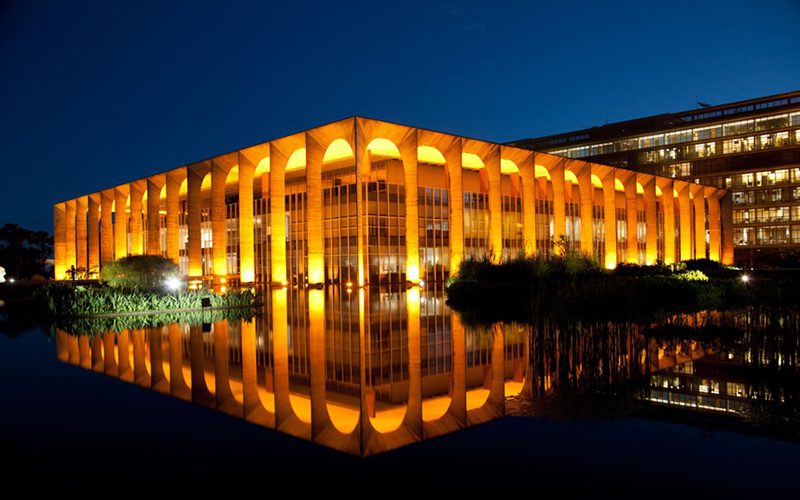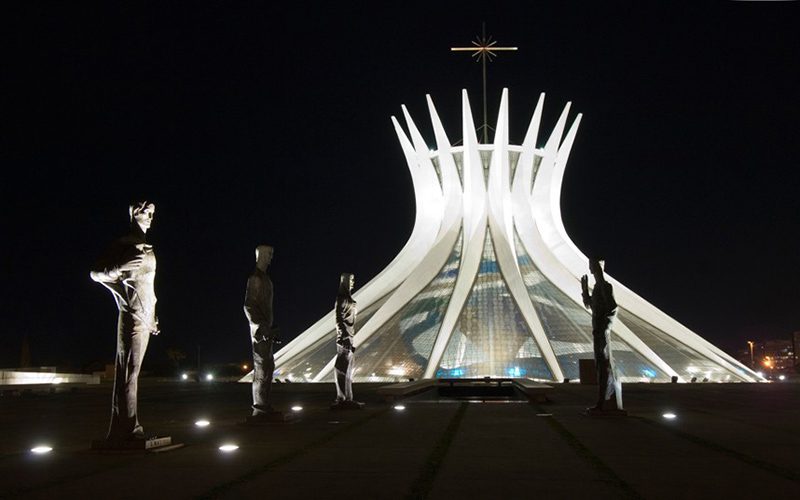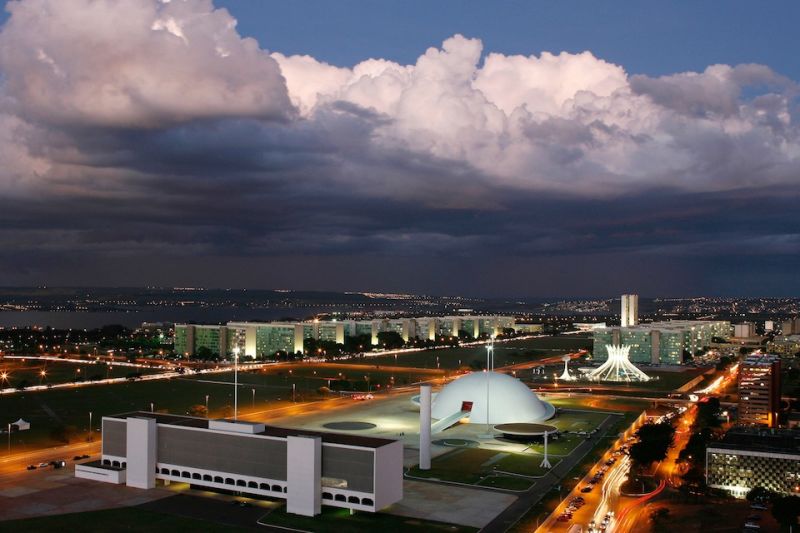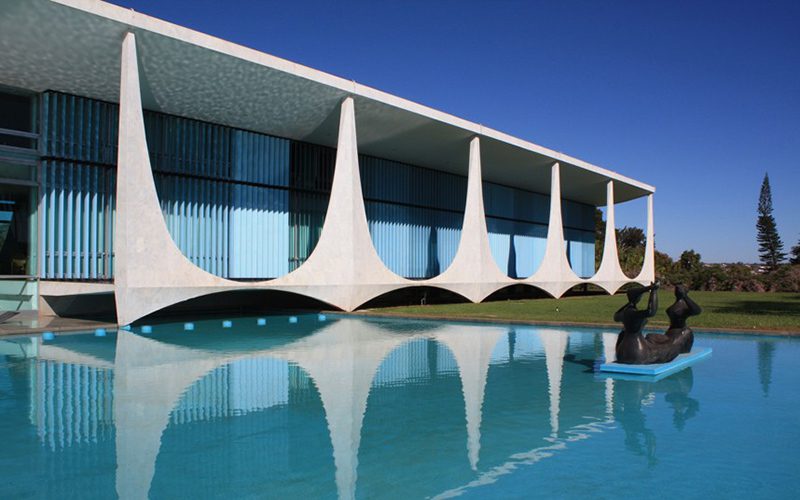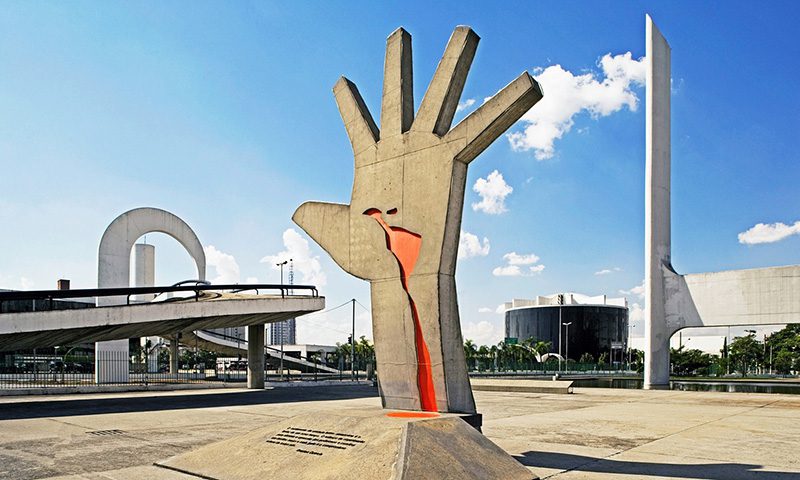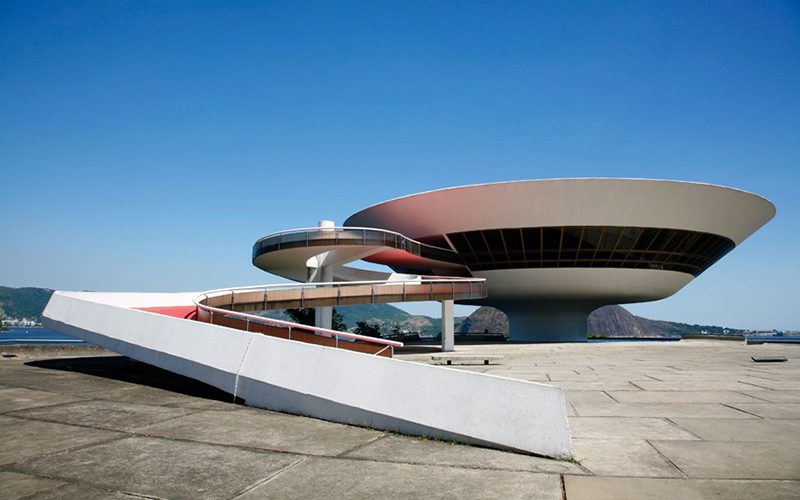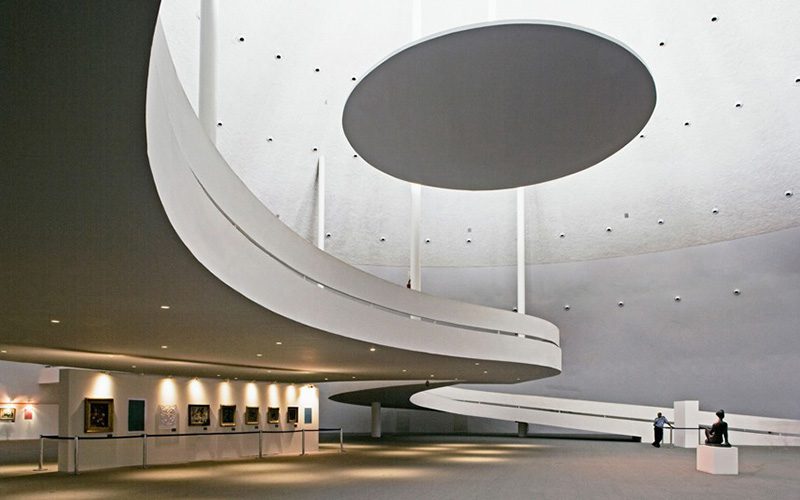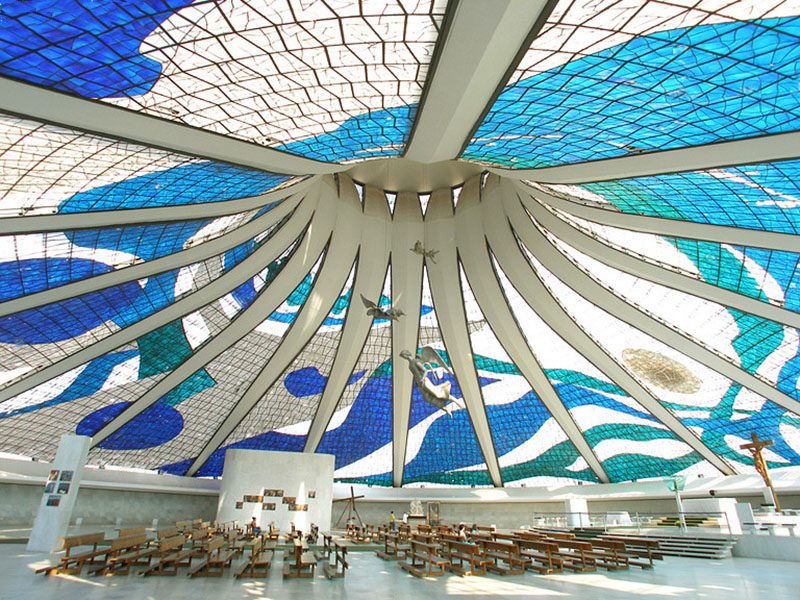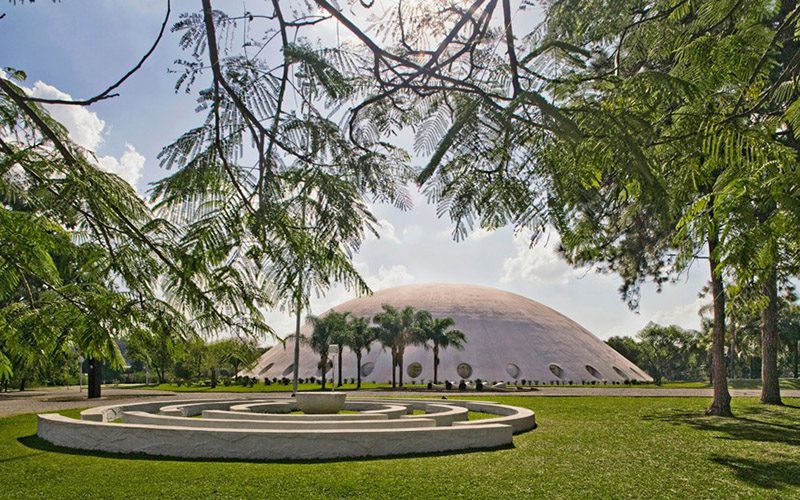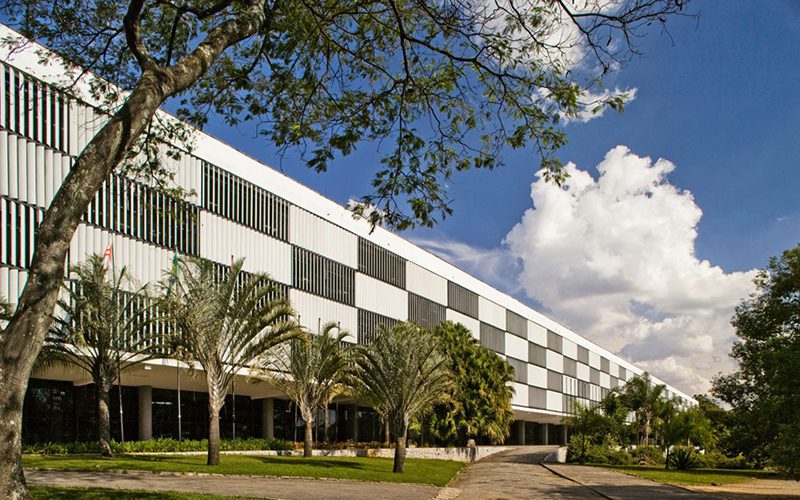ARCHITECTURE: Oscar Niemeyer
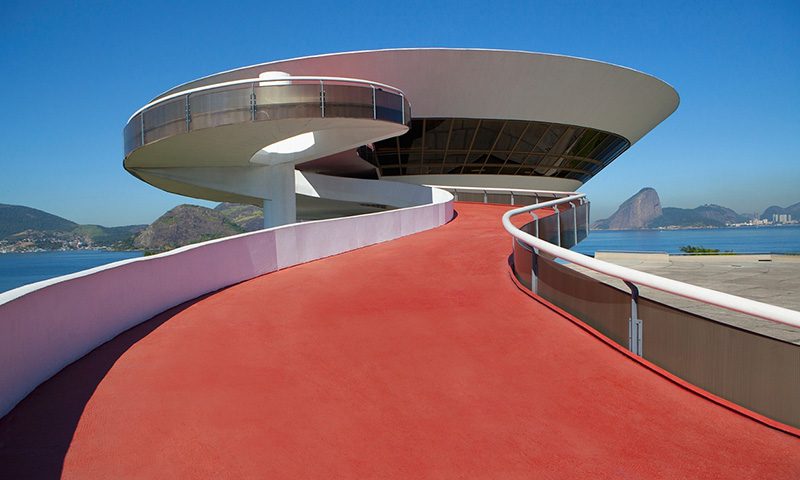 The Brazilian architect Oscar Ribeiro de Almeida Niemeyer Soares Filho, known as Oscar Niemeyer (15/12/1907-5/12/2012), was universally regarded as the very last of the 20th Century’s major Architectural masters, an astonishing survivor whose most famous accomplishment, Brasília, the capital city of Brazil, architecture combines sculptural monumentality with classic order. Niemeyer’s love of curves and natural lines inform all of his projects, and Niemeyer’s buildings not only are breathtaking works of engineering, but also incredible works of beauty.
The Brazilian architect Oscar Ribeiro de Almeida Niemeyer Soares Filho, known as Oscar Niemeyer (15/12/1907-5/12/2012), was universally regarded as the very last of the 20th Century’s major Architectural masters, an astonishing survivor whose most famous accomplishment, Brasília, the capital city of Brazil, architecture combines sculptural monumentality with classic order. Niemeyer’s love of curves and natural lines inform all of his projects, and Niemeyer’s buildings not only are breathtaking works of engineering, but also incredible works of beauty.
By Dimitris Lempesis
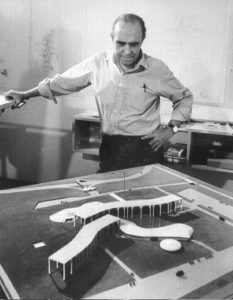 Oscar Niemeyer was born in the hillside district of Rio de Janeiro, he later recalled, “When I was very little, my mother said I used to draw in the air with my fingers. I needed a pencil. Once I could hold one, I have drawn every day since”. Niemeyer graduated from Barnabitas College in 1923 and received a degree in Architecture in 1934 from the National School of Fine Arts in Rio de Janeiro. Shortly before graduation, he joined the office of Lúcio Costa, an architect from the Modernist school. Niemeyer worked with Costa on many major buildings between 1936 and 1943, including the design for Brazil’s Ministry of Education and Health building, which was part of a collaboration with Le Corbusier. Costa and Niemeyer also worked together on Brazil’s iconic pavilion in the 1939 New York World’s Fair. In 1941, Niemeyer launched his solo career by designing a series of buildings called the Pampulha Architectural Complex in the city of Belo Horizonte. Here, Niemeyer started developing some of his design trademarks, including the heavy use of concrete and a propensity toward curves. “I consciously ignored the highly praised right angle and the rational architecture of T-squares and triangles, in order to wholeheartedly enter the world of curves and new shapes made possible by the introduction of concrete into the building process”. Niemeyer’s status as a rising star in the architectural world was confirmed when he was chosen to represent Brazil as part of the team to design the new headquarters of the United Nations in New York City, the final building was based primarily on Niemeyer’s design, with significant elements also taken from his old collaborator, Le Corbusier. Following the completion of the United Nations building in 1953, Niemeyer won an appointment as dean of Harvard University’s Graduate School of Design, but he was refused an American work visa by the United States government due to his membership in Brazil’s Communist Party. In 1956, Juscelino Kubitschek, the president of Brazil and a close friend of Niemeyer, came to the architect with a proposal, asking Niemeyer to become the new chief architect of public buildings in the country’s new capital, Brasilia, a Modernist civic metropolis being built from scratch in the interior of the country. Niemeyer eagerly accepted, designing buildings that went along with his utopian vision of government. “This was a liberating time. It seemed as if a new society was being born, with all the traditional barriers cast aside …. when planning the government buildings for Brasilia I decided they should be characterized by their own structures within the prescribed shapes … I tried to push the potential of concrete to its limits, especially at the load-bearing points, which I wanted to be as delicate as possible so that it would seem as if the palaces barely touched the ground”. Niemeyer designed several buildings in Brasilia, including the presidential palace, the Brasília Palace Hotel, the Ministry of Justice building, the Presidential Chapel and the Cathedral. After the inauguration of the new capital city in 1960, Niemeyer resigned from his position as the government’s chief architect and returned to private practice. Niemeyer had joined the Brazilian Communist Party in 1945, this became a serious problem in 1964, when the Brazilian military overthrew the government in a coup, Niemeyer, viewed by the army as an individual with dangerously left-wing sympathies, had his office ransacked. Spooked, the architect left the country in 1965, resettling in France and mainly designing buildings in Europe and northern Africa. He also turned to designing furniture, which also included his trademark use of sinuous curves. Niemeyer did not return to Brazil until the end of the military dictatorship in 1985. Niemeyer received the Pritzker Architecture Prize in 1988, for his Cathedral of Brasilia. In his acceptance speech, Niemeyer explained his design philosophy: “My architecture followed the old examples, beauty prevailing over the limitations of the constructive logic. My work proceeded, indifferent to the unavoidable criticism set forth by those who take the trouble to examine the minimum details, so very true of what mediocrity is capable of. It was enough to think of Corbusier saying to me once while standing on the ramp of the Congress: “There is invention here.”” Semi-retired since the mid-1980s, he made the Memorial Juscelino Kubitschek (1980), the Pantheon, (1985) and the Latin America Memorial (1987). The memorial sculpture represents a wounded hand, whose wound bleeds in the shape of Central and South America. In 1988, at 81, Niemeyer was awarded the Pritzker Architecture Prize. From 1992 to 1996, Niemeyer was the president of the Brazilian Communist Party. He was replaced by Zuleide Faria de Mello in 1996. He designed at least two more buildings in Brasilia, the Memorial dos Povos Indigenas and the Catedral Militar, Igreja de N.S. da Paz. In 1996, at the age of 89, he was responsible for the design of the Niterói Contemporary Art Museum in Niterói, a city next to Rio de Janeiro. The building cantilevers out from a sheer rock face, offering a view of Guanabara Bay and the city of Rio de Janeiro. At the age of 103 Oscar Niemeyer still went into his office every day to work on designs and oversee projects, Niemeyer continued to press for a better world through better design. “It is important, that the architect think not only of architecture but of how architecture can solve the problems of the world. The architect’s role is to fight for a better world, where he can produce an architecture that serves everyone and not just a group of privileged people”. Niemeyer died in Rio de Janeiro, Brazil, on 5/12/12. He was 104 years old. The funeral service was held in Brasilia, at the Presidential Palace he designed more than 50 years earlier.
Oscar Niemeyer was born in the hillside district of Rio de Janeiro, he later recalled, “When I was very little, my mother said I used to draw in the air with my fingers. I needed a pencil. Once I could hold one, I have drawn every day since”. Niemeyer graduated from Barnabitas College in 1923 and received a degree in Architecture in 1934 from the National School of Fine Arts in Rio de Janeiro. Shortly before graduation, he joined the office of Lúcio Costa, an architect from the Modernist school. Niemeyer worked with Costa on many major buildings between 1936 and 1943, including the design for Brazil’s Ministry of Education and Health building, which was part of a collaboration with Le Corbusier. Costa and Niemeyer also worked together on Brazil’s iconic pavilion in the 1939 New York World’s Fair. In 1941, Niemeyer launched his solo career by designing a series of buildings called the Pampulha Architectural Complex in the city of Belo Horizonte. Here, Niemeyer started developing some of his design trademarks, including the heavy use of concrete and a propensity toward curves. “I consciously ignored the highly praised right angle and the rational architecture of T-squares and triangles, in order to wholeheartedly enter the world of curves and new shapes made possible by the introduction of concrete into the building process”. Niemeyer’s status as a rising star in the architectural world was confirmed when he was chosen to represent Brazil as part of the team to design the new headquarters of the United Nations in New York City, the final building was based primarily on Niemeyer’s design, with significant elements also taken from his old collaborator, Le Corbusier. Following the completion of the United Nations building in 1953, Niemeyer won an appointment as dean of Harvard University’s Graduate School of Design, but he was refused an American work visa by the United States government due to his membership in Brazil’s Communist Party. In 1956, Juscelino Kubitschek, the president of Brazil and a close friend of Niemeyer, came to the architect with a proposal, asking Niemeyer to become the new chief architect of public buildings in the country’s new capital, Brasilia, a Modernist civic metropolis being built from scratch in the interior of the country. Niemeyer eagerly accepted, designing buildings that went along with his utopian vision of government. “This was a liberating time. It seemed as if a new society was being born, with all the traditional barriers cast aside …. when planning the government buildings for Brasilia I decided they should be characterized by their own structures within the prescribed shapes … I tried to push the potential of concrete to its limits, especially at the load-bearing points, which I wanted to be as delicate as possible so that it would seem as if the palaces barely touched the ground”. Niemeyer designed several buildings in Brasilia, including the presidential palace, the Brasília Palace Hotel, the Ministry of Justice building, the Presidential Chapel and the Cathedral. After the inauguration of the new capital city in 1960, Niemeyer resigned from his position as the government’s chief architect and returned to private practice. Niemeyer had joined the Brazilian Communist Party in 1945, this became a serious problem in 1964, when the Brazilian military overthrew the government in a coup, Niemeyer, viewed by the army as an individual with dangerously left-wing sympathies, had his office ransacked. Spooked, the architect left the country in 1965, resettling in France and mainly designing buildings in Europe and northern Africa. He also turned to designing furniture, which also included his trademark use of sinuous curves. Niemeyer did not return to Brazil until the end of the military dictatorship in 1985. Niemeyer received the Pritzker Architecture Prize in 1988, for his Cathedral of Brasilia. In his acceptance speech, Niemeyer explained his design philosophy: “My architecture followed the old examples, beauty prevailing over the limitations of the constructive logic. My work proceeded, indifferent to the unavoidable criticism set forth by those who take the trouble to examine the minimum details, so very true of what mediocrity is capable of. It was enough to think of Corbusier saying to me once while standing on the ramp of the Congress: “There is invention here.”” Semi-retired since the mid-1980s, he made the Memorial Juscelino Kubitschek (1980), the Pantheon, (1985) and the Latin America Memorial (1987). The memorial sculpture represents a wounded hand, whose wound bleeds in the shape of Central and South America. In 1988, at 81, Niemeyer was awarded the Pritzker Architecture Prize. From 1992 to 1996, Niemeyer was the president of the Brazilian Communist Party. He was replaced by Zuleide Faria de Mello in 1996. He designed at least two more buildings in Brasilia, the Memorial dos Povos Indigenas and the Catedral Militar, Igreja de N.S. da Paz. In 1996, at the age of 89, he was responsible for the design of the Niterói Contemporary Art Museum in Niterói, a city next to Rio de Janeiro. The building cantilevers out from a sheer rock face, offering a view of Guanabara Bay and the city of Rio de Janeiro. At the age of 103 Oscar Niemeyer still went into his office every day to work on designs and oversee projects, Niemeyer continued to press for a better world through better design. “It is important, that the architect think not only of architecture but of how architecture can solve the problems of the world. The architect’s role is to fight for a better world, where he can produce an architecture that serves everyone and not just a group of privileged people”. Niemeyer died in Rio de Janeiro, Brazil, on 5/12/12. He was 104 years old. The funeral service was held in Brasilia, at the Presidential Palace he designed more than 50 years earlier.


